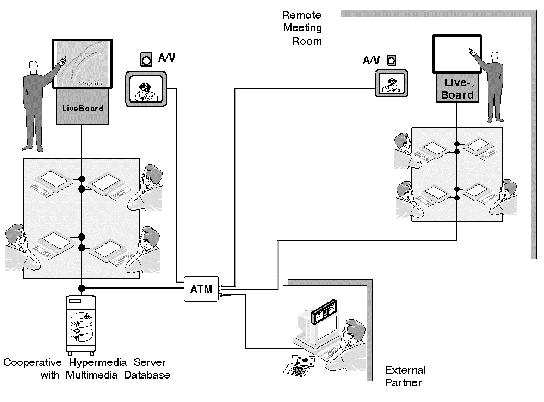
Virtual Meetings Scenario

by Jörg M. Haake and Norbert A. Streitz
Today, much of the time spent on group collaboration is devoted to meetings. In the past, different "electronic meeting rooms" have been developed in order to provide computer-based support focussing on various group activities. Unfortunately, most of these developments were more or less confined to the scenario of one physical meeting room and the support for the meeting activity was rather isolated from other phases of the overall collaboration. At GMD-Institute for Integrated Publication and Information Systems we are developing an environment in order to overcome these deficits. Our approach extends the physical boundaries of one meeting room while at the same time allowing face-to-face meetings within the room. This implies to couple several meeting rooms and remote offices and integrating them into what we call "virtual meetings". In addition, we take into account the importance of integrating the activities before and after a meeting and the requirements resulting from consecutive meetings by allowing smooth transitions between the various phases of comprehensive collaboration processes.
Two trends point to the necessity of providing integrated support for meetings of distributed groups. First, one can observe that there is an increase in cooperation between groups within companies transcending traditional boundaries ("virtual company") with respect to locations as well as domains of expertise resulting in more multi- and even interdisciplinary work efforts. Second, the formation of joint ventures and strategic alliances results in increasing collaboration of independent companies within and across countries resulting in organizations on demand often with a limited lifetime (==> " virtual organizations"). Both application scenarios require support for what we call "Virtual Group Meetings" satisfying the need to bridge the spatial and organizational distribution of groups.
Unlike desktop conferencing systems where different participants communicate from their individual offices using workstation computers, virtual meetings connect different groups each using an electronic meeting room supported by appropriate cooperation and communication infrastructures. The scenario requires to address the problem of sharing objects in global and local workspaces within both, the local working group and the set of distributed working groups. In addition, audio and video communication between the distributed groups has to be provided and integrated with workspace environments.
Application Scenario
A "virtual meeting" is held in interconnected multiple, distributed electronic meeting rooms (see figure). Additional external participants can be integrated into the meeting by using especially equipped workstations. All participants in this meeting can access, manipulate, and present information in the public workspace of the meeting and work simultanously in their private workspaces. Digital audio and video communication between participants in different meeting rooms, shared editors and presentation tools enable direct discussions, coordination, joint editing and presentations. Material prepared before the meeting can be presented, modified, and integrated with new information created during the meeting. All types of information created or manipulated in a meeting are stored and can be re-used after the meeting for subsequent work and can serve as a basis for the next meeting. In order to cope with the extensive requirements of transfering data between the different sites in a real time situation we will use an ATM network.

Application areas for "virtual meetings" are meetings in companies, research organizations, and administrations. We focus especially on those meetings which are concerned with creative processes such as design, planning or decision making including subprocesses as brainstorming, information structuring. These activities can be characterized as "distributed collaborative problem solving". Another application area is teaching and learning. Here, "distributed collaborative teaching/learning" may allow more participants to access limited human resources (i.e., a good teacher). In all scenarios, private meetings and closed user-communities can be supported by integrating advanced security concepts into the software.
Approach
In order to realize "virtual meetings", we use software components developed within GMD and components that have been developed within the ESPRIT project MICE. GMD components include the cooperative hypermedia server CHS, the hypermedia-based meeting support system DOLPHIN, and the security software SecuDE. MICE components include the audio and video conferencing tools ivs and vat. The advanced ATM infrastructure between the two GMD institutes, Publication Systems and Telecooperation Technology, in Darmstadt provides the necessary bandwidth for fast and comprehensive collaboration.
Since both GMD institutes in Darmstadt are connected to the Darmstadt metropolitan fiber optics network, other interested parties have the opportunity to use the prototypical solutions currently under development. The project "Virtual Meetings based on ATM" is a joint cooperation between the department OCEAN at GMD Institute for Integrated Publication Systems and the GMD-Institute for Telecooperation Technology.